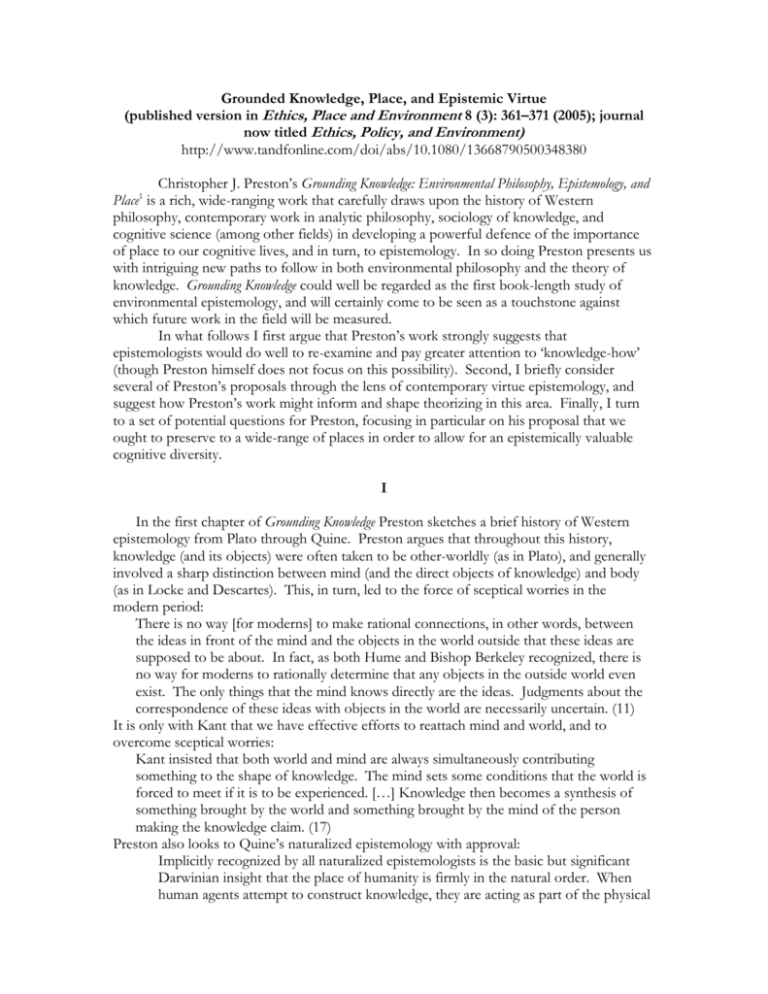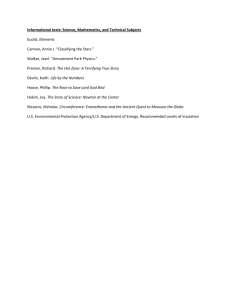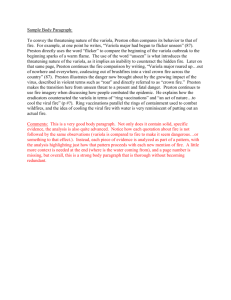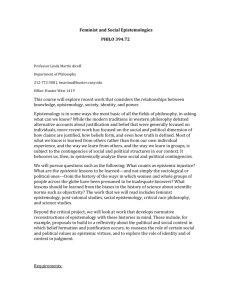Grounded Knowledge and Epistemic Virtue
advertisement

Grounded Knowledge, Place, and Epistemic Virtue (published version in Ethics, Place and Environment 8 (3): 361–371 (2005); journal now titled Ethics, Policy, and Environment) http://www.tandfonline.com/doi/abs/10.1080/13668790500348380 Christopher J. Preston’s Grounding Knowledge: Environmental Philosophy, Epistemology, and Place1 is a rich, wide-ranging work that carefully draws upon the history of Western philosophy, contemporary work in analytic philosophy, sociology of knowledge, and cognitive science (among other fields) in developing a powerful defence of the importance of place to our cognitive lives, and in turn, to epistemology. In so doing Preston presents us with intriguing new paths to follow in both environmental philosophy and the theory of knowledge. Grounding Knowledge could well be regarded as the first book-length study of environmental epistemology, and will certainly come to be seen as a touchstone against which future work in the field will be measured. In what follows I first argue that Preston’s work strongly suggests that epistemologists would do well to re-examine and pay greater attention to ‘knowledge-how’ (though Preston himself does not focus on this possibility). Second, I briefly consider several of Preston’s proposals through the lens of contemporary virtue epistemology, and suggest how Preston’s work might inform and shape theorizing in this area. Finally, I turn to a set of potential questions for Preston, focusing in particular on his proposal that we ought to preserve to a wide-range of places in order to allow for an epistemically valuable cognitive diversity. I In the first chapter of Grounding Knowledge Preston sketches a brief history of Western epistemology from Plato through Quine. Preston argues that throughout this history, knowledge (and its objects) were often taken to be other-worldly (as in Plato), and generally involved a sharp distinction between mind (and the direct objects of knowledge) and body (as in Locke and Descartes). This, in turn, led to the force of sceptical worries in the modern period: There is no way [for moderns] to make rational connections, in other words, between the ideas in front of the mind and the objects in the world outside that these ideas are supposed to be about. In fact, as both Hume and Bishop Berkeley recognized, there is no way for moderns to rationally determine that any objects in the outside world even exist. The only things that the mind knows directly are the ideas. Judgments about the correspondence of these ideas with objects in the world are necessarily uncertain. (11) It is only with Kant that we have effective efforts to reattach mind and world, and to overcome sceptical worries: Kant insisted that both world and mind are always simultaneously contributing something to the shape of knowledge. The mind sets some conditions that the world is forced to meet if it is to be experienced. […] Knowledge then becomes a synthesis of something brought by the world and something brought by the mind of the person making the knowledge claim. (17) Preston also looks to Quine’s naturalized epistemology with approval: Implicitly recognized by all naturalized epistemologists is the basic but significant Darwinian insight that the place of humanity is firmly in the natural order. When human agents attempt to construct knowledge, they are acting as part of the physical and biological world, and obeying all the relevant natural laws. With epistemology naturalized, knowing is no different in kind from other natural activities such as breathing, talking, or digesting. A science that investigates how we know should accordingly proceed not much differently from a science that investigates how we digest. (21) Preston thus sees Kant and Quine as especially important to the history of epistemology for reuniting mind and world. Kant requires that the world be compatible with certain a priori categories that determine how it is presented within the mind. Quine focuses on how we in fact form beliefs, as living, embodied creatures in the world. Preston himself takes a broadly Quinean, naturalized approach to epistemology. Where he departs from Quine, and moves forward, is in arguing for the importance of place and environment to the process of knowledge acquisition, rather than just the inner brain and psychology of the would-be knower: “And even though Quine did not appreciate it at the time, the wriggling, squiggling brain belongs in a wriggling, squiggling body that itself moves through a living, breathing, multi-dimensional world replete with texture and colour. This is potentially rich and rewarding epistemic territory to explore” (24). I would like to draw attention (briefly) to related areas in epistemology where Preston’s work might shed further light. In the Western tradition there has been a focus on pure theoretical knowledge as intrinsically valuable. As he writes, the study of the production of knowledge in the dominant tradition of Western philosophy has been pursued in settings designed to maintain the illusion that knowing is about transcending one’s natural situation in order to know from nowhere. The library and the closed office space have usually been considered the most reliable sites for the production of philosophical knowledge. The freedom from sensory distraction that these places offer allow philosophers to forget for a while that they are embodied creatures and enables them to engage in what appears to be the purest of all kinds of work, the work of the mind. (74) Treating propositional knowledge2, even of highly abstract propositions, as valuable for its own sake – indeed, as one of our highest achievements – would, of course, appeal to philosophers. But Preston’s work serves to remind us that the original value of knowledge is to be found in its use to creatures interacting with complex environments. In discussing James J. Gibson’s influential account of visual perception, Preston notes that Parsing vision in terms of affordances illustrates how the ecological account of perception continues to bind organism and environment together. To be an affordance, a pattern in the ambient array of information must persist and be meaningful for an organism. […] Perception becomes a process that unites an organism with the useful things that the environment presents to that organism. (60-1) Thus, while Preston focuses on correcting a tendency in the history of Western epistemology to strongly separate mind and world, his work suggests additional ways in which it might be useful to ground knowledge more firmly in the world – both to restore the value of knowledge as useful to organisms, and to examine how we are to fit our roles as epistemic agents into our broader concerns as living, embodied creatures who have other goals, needs, and desires. Grounding Knowledge also provides a basis for focusing greater attention on knowledgehow. In particular, acquiring propositional knowledge will often require knowing-how to interact with an environment: [For Gibson] The idea of vision as essentially a matter of processing stimuli is rejected. During ongoing embodied interactions, information is actively obtained from the environment by the perceptual system in the form of a flowing, ambient array of energy. Seeing a table, then, is not a matter of processing photons of light on the retina but of discovering a certain type of structure in the environment by moving through the optic array. (59-60) Knowing-how to interact successfully with an environment to obtain desired information will thus be of tremendous importance to organisms – including humans. Preston himself is careful to stress that he does not want to reduce all knowledge to knowledge-how (64). This seems quite correct; still, his work illustrates crucial ways in which skills and abilities (i.e., forms of knowledge-how) will often be required for the successful acquisition of propositional knowledge. Knowing how to scan the optic array posited by Gibson, read maps, use computers, and gauge the time based on the sun’s position in the sky are all examples of how knowing-how to use external features of the environment can improve (or even be crucial to) our cognition and acquisition of knowledge-that. More broadly, by focusing on the knowledge of embodied creatures, Preston’s position encourages looking at knowledge-how in general (not just knowing-how to gain knowledge-that) as an especially important and valuable kind of knowledge for creatures who are actively participating in the world – and not simply sitting in armchairs. 3 II We can now turn to a consideration of how Preston’s work might serve to inform contemporary analytic epistemology, particularly virtue-based approaches to the field. Consider Ernest Sosa’s influential characterization of intellectual virtue: (V) S has an intellectual virtue V (C, F) relative to environment E if and only if S has an inner nature I such that if (i) S is in E and has I, (ii) P is a proposition in field F, (iii) S is in conditions C with respect to P then (v) S is very likely to believe correctly with regard to P.4 Intuitively, on this understanding of intellectual virtue, various faculties (vision, hearing, etc.) are considered virtuous for a particular creature (S) in a given environment (E) if and only if they reliably lead S to the truth with respect to a particular range of propositions (F) in the given conditions (C). Vision will typically be an intellectual virtue for adult humans across a wide range of environments – from bank vaults to hilltops. Still, within an environment that is generally conducive to knowledge there might be particular conditions where a given faculty fails. Vision works well in clearings in heavily wooded areas (and thus works well in such environments), but in the particular conditions of a snow squall, vision is no longer a reliable source of true belief for an agent, and thus would not be a virtue in these specific conditions (particularly if the agent continued to form beliefs on the basis of vision without any recognition of the significance of the weather conditions). Sosa acknowledges that the line between environment and conditions is not sharp, but the distinction still usefully contrasts the general standing characteristics of an environment with more local, isolated conditions within the same environment. Preston’s work brings into focus elements present in Sosa’s account of intellectual virtue, but which are typically passed-over. For example, Preston discusses Mark Rowlands’ environmentalist model of cognition, and its epistemic significance: “[Rowlands] explains how Gibson’s optic array can be thought of as an external structure that an organism manipulates and transforms during the sensorimotor part of the perceptual process, suggesting that this makes certain aspects of perception external to the head. And he describes physical reminders such as knots tied in fabric and distinctive books on library shelves as environmental structures that secure at least some of our information-processing load in the world rather than in the head. It is not just that the content of a belief is found in the world as in semantic externalism; in many cases the actual processing of that information also goes on in the world external to the cognizing body.” (68)5 Drawing on such work by cognitive scientists and philosophers of mind like Rowlands, Preston argues that the reliable acquisition of true beliefs in various environments (particularly in the case of perceptual beliefs) will require skills and knowing how to manipulate and manoeuvre within the environment. We cannot simply drop an agent into an environment, and assume that her inner intellectual virtues (including perceptual faculties) will then produce reliably-true beliefs. The agent will need to scan the optic array (in the case of vision), move (perhaps to get a better look), shift attention, and so on. As Preston argues, knowledge acquisition is generally an active, engaged process, rather than a passive reception of information. Note that this is quite compatible with Sosa’s account of an intellectual virtue, but that we now have reason to see such virtues as potentially involving more than the traditional faculties of memory, vision, hearing, and so on; abilities to negotiate environments in ways that allow for the effective use of these faculties could now be seen as part of broader intellectual virtues. Consider next how we might try to improve the epistemic performance of an agent. Virtue epistemologists (indeed, epistemologists in general) will naturally tend to look to changing an agent’s inner nature (I) in order to create new, derivative intellectual virtues. That is, the agent will modify stable states of her brain and body (presumably through learning) so as to be effective at arriving at the truth within a certain field of propositions, within a given environment. Preston draws out an alternative method for improving the belief-formation of epistemic agents – in addition to, or rather than modifying the agent, we can modify her circumstances. The laboratory (taken broadly) can be seen as a paradigm instance of creating an environment (E) and set of conditions (C) under which an agent can more effectively and accurately form beliefs about a range of propositions. And we can move beyond the laboratory. For example, humans with visual impairments can face significant difficulties in acquiring knowledge in most human communities. Epistemic access can be improved across a broad range of environments and fields of propositions through a range of improvements including auditory signals at street intersections, books and articles produced in auditory formats, and so on. Note that while these epistemic improvements will also require some learning on the part of the agent (e.g., we cannot simply drop an untrained person into a laboratory), the environment plays a fundamental role in any improved epistemic performance that results. Preston’s work also supports calls for place-based learning. Preston himself emphasizes different cognitive values and foci that may arise in different places. But note how, more broadly, being directly exposed to an environment can lead us to draw inferences that we would not otherwise; and this need not be a result of changed cognitive values. Consider the true proposition that Onondaga Lake in Syracuse, NY contains particularly high and dangerous levels of phosphorous and ammonia. We can read this in a textbook (or exchange essay, for that matter). But we could also visit the lake to become directly acquainted with it, and perhaps even perform measurements ourselves. Even if we assume that the same propositions are learned in both cases, notice that the mode of presentation can have a strong impact on how we integrate this knowledge into our general corpus of beliefs and desires. When the information is learned in a textbook we may not be quick to tie it to our moral beliefs. But when we directly interact with a place, this immersion can lead us to draw different connections. Compare: to merely read stories of the impacts of an earthquake may not fully capture our attention. Seeing images (we are in many ways a visual species) can trigger moral dispositions that may lie dormant to information presented in a different format; and to actually be present in the midst of such impacts would surely elicit our moral responses still more forcefully. Similarly, to merely read of a mountain would likely have different cognitive impacts from hiking or living on the same mountain, including possibly quite different valuations of the mountain and its life-communities. Preston notes - cautiously but plausibly - that rarely will moving between environments have a significant impact on one’s cognitive life: [I]t is very rare for environments to actually be different enough to make any significant difference to perception. I had to go from a semi-urban environment to Alaska to find a dramatic enough change in landscape to feel even slightly perceptually dislocated. It is more common not to notice any kind of perceptual adjustment between places. Places may count perceptually and cognitively, but it is rare that this is a very dramatic kind of effect. (97) Still, it does seem that local conditions (‘C’ from Sosa’s account of epistemic virtue) often do have some such impact, at least temporarily. Compare an open field on a summer day with the same field during a heavy snowstorm. Attempting to do difficult, precise intellectual work in an extremely loud environment is (for most) frustrating at best; to focus on a task in such circumstances will require developing strong powers of concentration, and an ability to screen out interfering stimuli. This might be especially true of a busy city, where our attention is easily drawn to the human voices and noises that surround us. And note the feeling of relief, and the welcome return of quiet when the crowd and noise are removed. When we walk in darkness, we walk with our hands held forward, taking advantage of touch in ways that we rarely, if ever, do in the same environment when brightly-lit. Thus even within the same location we can encounter significantly different cognitive environments, given changing local conditions. III In this final section I wish to turn to a set of questions for Preston. These do not focus on the foundation of Preston’s project; rather, they arise as we attempt to work out how exactly to implement the positive proposals he suggests. In particular, Preston advocates the preservation of diverse environments to provide an important cognitive diversity, with an eye to improving our epistemic practices (by exposing bias, providing alternative theoretical frameworks, different foci of epistemic attention, and so on). As he writes, We can now begin to appreciate how place is also an important source of epistemically valuable diversity. As [Sandra] Harding pointed out, location in heterogeneous nature exposes people to different kinds of regularities that influence the things they think are important. […] Fishermen, firewood gatherers, automotive workers, ski patrollers, and those living at the bottom of deep canyons all interact with physical environments in ways that may influence their values and how they prioritize them. […] These physical locations yield perspectives that can be used as toolboxes rather than regarded as prison houses for the knowledge process. Like other factors contributing to cultural diversity, a diversity of physical environments is a valuable source that helps to increase the number of perspectives available. (128-30) Preston presents a strong case for the preservation of such place-based perspectives, but questions arise as we consider more precisely what this entails. While there is an obvious epistemic value to cognitive diversity for our general shared bodies of knowledge, we do have other cognitive goals - both as individuals and as societies. And here, homogeneity rather than heterogeneity may be of greater importance. At a social level homogeneity helps us to produce consensus, and mutual understanding. This is not to suggest, of course, that we ought merely to engage in some form of uncritical ‘group-think’; the point is rather that we need at least some shared experience, epistemic standards, and so forth in order for any critical engagement of ideas to occur. We risk talking past each other without some shared core of values and experience. For example, if we have a broad range of diverse groups living in highly diverse environments, will communication across the groups be effective? We are presented with something of a dilemma: if the cognitive impact of diverse places is significant enough to be epistemically relevant, it is plausible to think that to that same extent there will be difficulties in communicating with others, and allowing them to be justified in forming beliefs based on testimony. Compare: your having a vision of God does not automatically translate into justification for my belief in God (or at least not to the same degree), even if you describe your vision to me honestly. Aspects of your experience may not be adequately captured in your testimony, and I may lack appropriate background beliefs and experiences that would allow me to be justified in believing on the basis of your vision (for example, perhaps the interpretation of your vision relies upon a religious framework with which I am entirely unfamiliar). Similarly, your testimony based upon experiences in various places or environments may not lead to justified beliefs for me, even if you testify honestly. Certain aspects of your experiences may be ineffable (or at least difficult to properly render into ordinary language), and I may lack an adequate conceptual and experiential apparatus to fully appreciate your testimony. This problem may be most pressing in the case of sublime encounters, or where the place from which you speak is rich in cultural overlays.6 This suggests that as environmental philosophy and epistemology develop, testimony will be a key concept; how do we translate the experiences of others into knowledge for ourselves or for society as a whole? And how can we help to ensure that our own testimony is effective in providing others with justification for various beliefs and attitudes? This will take on additional importance if we wish, as a society, to be able to draw upon the cognitive impacts of diverse places and environments, without needing to send masses of individuals into these areas for exposure. At the level of the individual knower, homogeneity of environments allows one to act efficiently wherever one goes. Consider an all-too familiar homogeneous environment: the shopping mall. One can walk into most such malls in North America, expect the same stores, know how to interact with the clerks, recognize the same products, etc. One can find a foodcourt, and know that washrooms will be nearby, etc. There will be maps (designed by and for humans) near main entrances. Beyond this, these are human-constructed environments, ones that reflect our minds, our ways of thinking (consider the square grids of many modern cities). There are road signs informing us of exits so that we don’t have to memorize this information – and we can more easily navigate unfamiliar regions. Our calculators, our cars, and our computers all reflect and expand our human thinking. We thus arrive at a tension in our epistemic goals. While a wide range of places and environments will provide humanity with a desirable cognitive diversity, a homogeneity grounded in human modifications to the environment might make each individual knower more effective. One can thereby act and know effectively across countries, languages, and continents. And again, this same homogeneity at the social level will allow for broader, more effective communication and testimony across knowers. If we continue to focus on Preston’s work as it applies to individual knowers, we arrive at further questions. Should we all, as individuals, go out into different environments? Preston’s proposal opens up the possibility of mass movements of individuals to extremely different environments in search of cognitive stimulation – to stave “off the monotonous regularity of habit that Dewey feared” (130). And if we only go to a space for a short time, will there be any significant cognitive impact? Note how tourists often perceive environments in quite different ways from locals. For example, Kaplan and Kaplan report on a study where it was found that out-of-province ferry riders in British Columbia, when asked to indicate their preferences for views of the coastline, had much stronger preferences for clearcuts and natural baldspots than locals (at least in part as they were less likely to recognize such areas as the likely result of timber harvesting).7 There is thus the possibility of ‘cognitive tourists’ forming false or skewed judgements concerning different places, which might in turn lead to flawed cognitive schema or values (to the extent that such new schema and values arise). Will we retain much afterwards, or when we return home will we simply fall back into our old values and ways of perceiving? These are, of course, empirical questions, but ones that would be well worth investigating. Perhaps we could simply open up a range of environments to people as cognitive tourists, while keeping many regions comparatively untouched by humans. This might be adequate for individual knowers; it will give us a wide range of possibilities for reshaping and creating the cognitive schema that Preston emphasizes (drawing upon the work of Mark Johnston).8 But for a society this might not be adequate; if its citizens merely experience the same range of environments, the society might lack a broader diversity. And this might encourage a society to engage in a certain form of ‘epistemic imperialism’. To secure a range of perspectives, Western industrialized societies will send still more anthropologists to work with indigenous peoples in order to draw upon their sense of place, and perhaps unique cognitive schema. Simply being in a different spatial location may give us some cognitive benefits; but to be in a place (with the rich cultural overlays that are associated with a place rather than a mere location) might require extended living in the place, and with those who live in this place. To the extent that Preston is right, we will have additional pressure to open up areas little touched by humans. Antarctica provides an extreme environment; indeed, for the vast majority of humans on the planet it seems to offer conditions so different as to have a significant impact upon our cognition. But we now have an added pressure to have large numbers of humans experience such a cognitive environment, in order to provide welcome place-based cognitive diversity (both for society as a whole, and for the benefit of individual epistemic agents). Still, this is perhaps an acceptable price to pay for the preservation (in some form) of such environments. Preston readily acknowledges that human, artifactual environments will shape our cognitive schema just as much as less-humanized places, and that these artifactual environments can also be sources of cognitive diversity. But he argues that we have particularly strong reasons to preserve diverse natural environments. For example, Preston suggests that Within the human realm, by contrast, we rely heavily on architects and planners to make our artifactual environments diverse. We are forced into this dependence because the building materials out of which these environments are constructed, the economic considerations according to which they are planned, and the political structures that enable them to evolve (and us to evolve in them) continually pull these environments toward homogeneity rather than diversity. The ride into town from the airport is much the same whether you are in Bangor, Maine, or Sacramento, California. The inside of a plane or a car hardly chances from one side of the world to the other. Natural environments, on the other hand, have variability and unpredictability built into them. (134) I’m inclined to agree with Preston, though one could press certain objections here. The inside of a fighter jet is quite different from that of a cargo plane, which is different from that of a large passenger aircraft, and so on. Perhaps those of us who find planes to be similar simply aren’t paying enough attention to subtle differences (akin to those who might feel that if one has seen one redwood, one has seen them all). More importantly, consider the similarity among cars. Preston is correct, but again notice the value in this similarity. If one learns how to drive a car, one can drive almost all cars around the world. The homogeneity of cars provides important epistemic advantages – knowing how to drive is a skill that can transfer across environments. And having similar traffic rules across cities, provinces, and nations again allows for easy and effective adaptation across regions and places. The broader point, of course, echoes the above discussion of homogeneity. We need not see the homogeneity of humanized environments as the mere result of economic or political considerations; it may well be the result of common human needs and preferences, and a source of epistemic efficiency and power. While I lament with Preston many of the forms of homogenization that are occurring across human, artifactual environments (and the loss of non-artifactual environments), it might be worthwhile to further pursue the question of which forms of homogeneity and heterogeneity are desirable, and which are not. Finally, recall Preston’s comment that moving between places typically will not have dramatic impacts upon one’s cognition and cognitive schema. We might wonder whether artifactual environments could potentially provide the most disruptive, unusual places for shaping human cognition insofar as we could deliberately create such environments so as to achieve precisely these sorts of effects. We can create environments with near-zero gravity, or with artificially powerful gravity (through strong acceleration), or with highly unusual visual or auditory impacts, and so on.9 We can deliberately manipulate artifactual environments so as to create different bodily experiences; as such, these might be more effective in shaping our cognitive schema than naturally-occurring environments. On the other hand, such artifactual environments would not capture other important epistemic impacts (noticing alternative connections between our beliefs, forming beliefs with varying degrees of vivacity or under different modes of presentation, coming to pay attention to different features of our environment as important, and so on) that come with non-artifactual places.10 As such, Preston’s call to preserve diverse non-artifactual environments stands as important and plausible, particularly if we look at the broader epistemic impacts of such environments beyond their influence on Johnson-style cognitive schema.11 Preston presents both an important examination of the role of place and environment in epistemology, and a spur to further investigation. His work brings to the fore questions concerning such issues as the value of diverse places as sources of cognitive diversity (and the question of the value of homogeneity and heterogeneity across environments), and the importance of being able to successfully interact with an environment in coming to acquire knowledge. Grounding Knowledge provides a well-argued case to go beyond the epistemologist’s traditional focus on the inner mental workings of agents (and corresponding true propositions out in the world), to include an examination of the environments and places in which knowledge-acquisition occurs; not as mere locations where agents happen to find themselves, but as active forces that can shape our cognitive schema, focus our attention, influence the connections that we draw between beliefs, and ultimately thwart or aid us in our efforts to achieve knowledge.12 Christopher J. Preston, Grounding Knowledge: Environmental Philosophy, Epistemology, and Place (Athens, Ga.: The University of Georgia Press, 2003). 2 That is, knowledge that a given proposition is true. For example, ‘Alicia knows that snow is white’. Such propositional knowledge (‘knowledge-that’) is often contrasted with ‘knowledge-how’ – e.g., knowing how to perform CPR, or knowing how to use a compass. The locus classicus for this distinction is Gilbert Ryle’s The Concept of Mind. (Chicago: University of Chicago Press, 1949), especially ch. 2. 3 The knowledge-how / knowledge-that distinction has recently been subject to much scrutiny. It is beyond the scope of the current essay to address the recent debate. Suffice to say that even if knowledge how can be reduced to knowledge that, the basic claim would still stand: we should focus more on how we actively acquire knowledge that, and also focus on how knowledge (be it how or that) allows us to act effectively as living creatures in complex environments. For recent work on the distinction, see Paul Snowdon, “Knowing How and Knowing That: A Distinction Reconsidered”, Proceedings of the Aristotelian Society CIV (2004), pp. 1-29; Jason Stanley and Timothy Williamson, “Knowing How”, Journal of Philosophy XCVIII (2001), pp. 411-44; and Stephen Schiffer, “Amazing Knowledge”, Journal of Philosophy XCIX (2002), pp. 200-2. 4 Ernest Sosa, “Intellectual Virtue in Perspective” in his Knowledge in Perspective (New York: Cambridge University Press, 1991), p. 286. Note that Sosa further refines this basic account of intellectual virtue in the same paper; these modifications are not crucial for our purposes here. 5 Preston refers to Mark Rowlands, The Body in Mind (New York: Cambridge University Press, 1999), and The Environmental Crisis (New York: St. Martin’s Press, 2000). 6 And note that these may be among the most interesting and valuable environments in terms of cognitive impacts and diversity. 7 Rachel Kaplan and Stephen Kaplan, The Experience of Nature: A Psychological Perspective. (New York: Cambridge University Press, 1989), pp. 82-3. They refer to P.A. Miller, Visual Preference and Implications for Coastal Management: A Perceptual Study of the British Columbia Shoreline (University of Michigan: Unpublished doctoral dissertation, 1984). 8 See Mark Johnson, The Body in the Mind. (Chicago: University of Chicago Press, 1987). Johnson defines a schema as “a recurring, dynamic pattern of our perceptual interactions and motor programs that gives coherence and structure to our experience” (xiv). As Preston notes, Johnson believes that most of our schemas arise out of our being embodied creatures interacting with our environment. These schemas can then provide structure to our thinking in other areas. Thus, our balance schema (which arises for us as teetering bipeds who need to stand upright, carry loads, run, etc.) provides a “structure for our conceptions of legal justice, moral fairness, psychological health, systemic balance, and mathematical equality” (Preston, 33). If Johnson is correct, then changes to our basic physical environment could lead to new schemas, which in turn could influence and reshape our thought in a wide-range of areas beyond perception. 9 Perhaps less realistically, we can recall Frank Jackson’s thought experiment (in a rather different context) involving Mary, a young woman who is raised in a manipulated environment where she never encounters the colour red. See Frank Jackson, “Epiphenomenal Qualia”, Philosophical Quarterly 32 (1982), pp. 127-36. 10 This is not to deny that refocusings of attention, etc., would occur in artifactual environments designed to create unique cognitive impacts. Rather, the point is that quite different refocusings of attention, etc., would occur in various non-artifactual environments. 1 Note that Preston’s emphasis on the ‘variability and unpredictability’ of natural environments dovetails nicely with the work of those who argue for the value of wildness. See, for example, Ned Hettinger and Bill Throop, “Refocusing Ecocentrism: De-emphasizing Stability and Defending Wildness”, Environmental Ethics 21 (1999), pp.3-21. [There is, of course, much recent debate over such concepts as ‘wildness’ and ‘wilderness’; we need not delve into this here.] 12 Acknowledgements. 11








